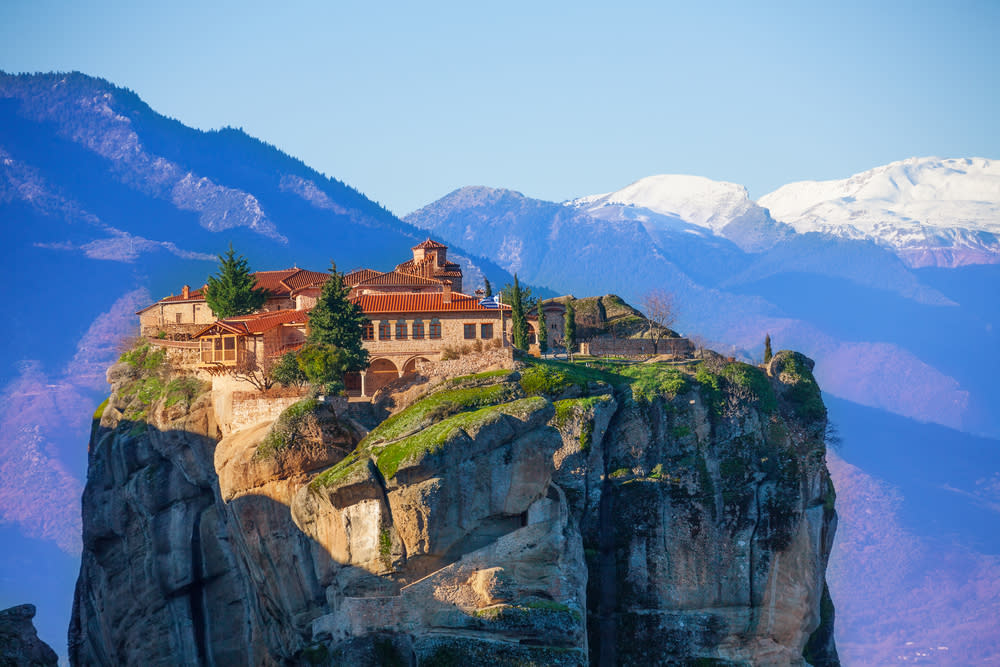More from Meteora
Main Menu
- 00:00
- 06:00
- 12:00
- 18:00
- 23:00
Meteora : Next 24-Hour Weather
Today - 25th April 2025
Sunrise 06:41
Sunset 20:21
Tomorrow - 26th April 2025
Sunrise 06:41
Sunset 20:21
Holiday Weather Now
Sorted by popularity:
Updated at 08:00 GMT
-
Temp feels like18°C64°F
-
Length of day13h 40m
-
Pressure29" (1011 hpa)
-
Visibility10 km (6miles)
-
Wind speed4 km/h
Sunrise 06:41
Sunset 20:21
-
Temp feels like:
18ºC (64 ºF)
-
Length of day:
13h 40m
-
Pressure:
29" (1011 hpa)
-
Visibility:
6 miles (10 km)
-
Wind speed:
4 km/h
Meteora has a Mediterranean continental climate with hot summers and cold winters. At higher elevations, which you are certain to climb to, it is generally cooler than at ground level. Sitting in the northwest of Thessaly, in the centre of Greece, Meteora is an area on the Thessalian plain of rocky pinnacles. Twenty-four Byzantine monasteries balance improbably on the top of these towering columns. These were initially built without steps and could only be reached by being hauled up in a great net. Now, steps carve their way up for easier ascents. However, Meteora is also a favourite with climbers who prefer to make things harder for themselves, scaling the sheer sides if the rocks.
Spring, from March till May, gets steadily warmer. The winter rains last into March, but as the season progresses these relent and the sun begins to come out more. The average high temperature increases from 15°C in March, to a pleasant 19°C in April and up to a gorgeous 25°C in May. Night times remain cold at the beginning of the season; the average low temperature is 6°C in March and 9°C in April, but in May it climbs up to 14°C. Late spring is probably the best time to visit the area as the days are hot without being uncomfortable and the nights are refreshingly cool but not cold. Meteora is also a very popular tourist destination, a winner with bus tours, and so going out of the peak summer season will hopefully mean avoiding the crowds.
Summer, from June till September, is hot and prone to thunderstorms. The average high temperature climbs from an already baking 29°C in June to a blistering peak of 32°C in July and August before getting back down to a more bearable 27°C in September. At night the heat and humidity can be stifling; the average low temperature stays up around 20°C. While summer is the most popular season to visit, probably out of convenience, it is not the most pleasant. While the sun blazes for many hours in the day it can often be interrupted by heavy downpours and the high temperatures can become unbearable. Far from the sea, there is little wind to temper the heat. Prices are also hiked up from the beginning of July till mid October.
Autumn, in October and November, sees temperatures drop and the heavy rains lighten. The average high temperature drops to 22°C in October and to 17°C in November, while night time lows drop from 14°C to 9°C. October is one of the better times to visit Meteora due to its more reasonable temperatures.
Winter, from December till February, is wet and cold, often seeing snow. The average high temperature of 12°C and the average low temperature of 4°C do not illustrate the bitter conditions that can develop, with icy winds blowing down from the mountains. Frosts are frequent and the sun becomes shy, withdrawing behind grey clouds for much of the day.
Meteora owes its climate to its distance from the sea and its location in the flat Thessalian plain, surrounded by mountains. Without the moderating effects of the sea the temperature is able to reach extremes. The mountains trap humid air forming frequent precipitation. It is important to remember that whatever the weather, shorts and sleeveless tops are prohibited in the monasteries.

















